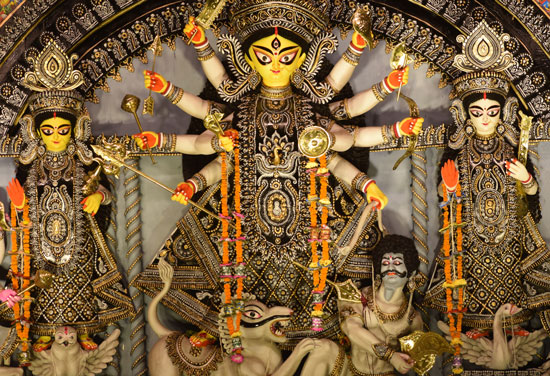 Change Language:
Change Language:

The story of Durga slaying Mahishasura is a significant event in Hindu mythology and is celebrated as the festival of Durga Puja in India. According to the mythological texts, Mahishasura was a formidable demon who had acquired immense power through penance and a boon from Lord Brahma, which made him nearly invincible. This boon granted him the ability to transform into various forms, making him a formidable adversary.
As Mahishasura's power grew, he started to wreak havoc on the world, threatening the gods and goddesses in heaven. Faced with this powerful demon, the gods sought the help of the divine Trinity: Brahma (the creator), Vishnu (the preserver), and Shiva (the destroyer). They combined their energies and created a radiant and fierce goddess known as Durga.
Durga, also called Mahadevi or the Great Goddess, is depicted as a warrior goddess riding a lion and armed with various weapons, including a trident, sword, bow, and arrows. She is a symbol of feminine power, compassion, and strength.
The battle between Durga and Mahishasura lasted for nine days and nine nights. Mahishasura, in his various forms, tried to defeat Durga, but she skillfully countered each of his attacks. On the tenth day, known as Vijayadashami or Dussehra, Durga finally gained the upper hand and beheaded Mahishasura, thus bringing an end to his reign of terror.

The ten days of the epic battle between Goddess Durga and the demon Mahishasura are collectively known as "Navratri." Each day is dedicated to a different form of the goddess, and she is worshipped with specific rituals and prayers. Here's a more detailed description of each day:
On the first day of Navratri, Goddess Durga is worshipped as Shailaputri, the daughter of the mountains. She is depicted with a half-moon on her forehead, riding a bull. Devotees invoke her blessings for strength and stability.
On the second day, Durga is worshipped as Brahmacharini, the embodiment of tapas (austerity) and penance. She symbolizes purity and devotion. Devotees seek her blessings to enhance their dedication to spiritual pursuits.
Goddess Chandraghanta is revered on the third day. She is depicted with a half-moon shape resembling a bell on her forehead, hence the name Chandraghanta. She represents peace and courage. Devotees pray to her for harmony and protection.
Kushmanda, the deity worshipped on the fourth day, is believed to have created the universe with her radiant smile. She is depicted with eight arms, riding a tiger. Devotees seek her blessings for prosperity and good health.
On the fifth day, Goddess Skandamata is venerated as the mother of Lord Skanda (Kartikeya), the war-god. She is depicted carrying her infant son on her lap. Devotees seek her blessings for motherly love, protection, and wisdom.
Katyayani, the goddess worshipped on the sixth day, is a fierce form of Durga. She is believed to have manifested to annihilate the demon Mahishasura. Devotees seek her blessings for courage and victory over obstacles.
Kalaratri, the fierce form of Durga, is revered on the seventh day. She is depicted with a dark complexion, disheveled hair, and a fierce expression. Devotees pray to her to remove all negativity and fears from their lives.
Goddess Mahagauri, worshipped on the eighth day, is believed to have a radiant and fair complexion. She represents purity and grace. Devotees seek her blessings for spiritual growth and enlightenment.
On the ninth day, Durga is worshipped as Siddhidatri, the giver of siddhis (divine powers). She is depicted with four arms and is surrounded by celestial beings. Devotees pray to her for blessings and fulfillment of their wishes.
The tenth day is celebrated as Vijayadashami or Dussehra, marking the triumph of Goddess Durga over the demon Mahishasura. It symbolizes the victory of good over evil and is celebrated with joyous processions and festivities.
Throughout these ten days, devotees engage in various rituals, fasts, and prayers to seek the blessings of Goddess Durga and celebrate the victory of righteousness.

Try out the other sections